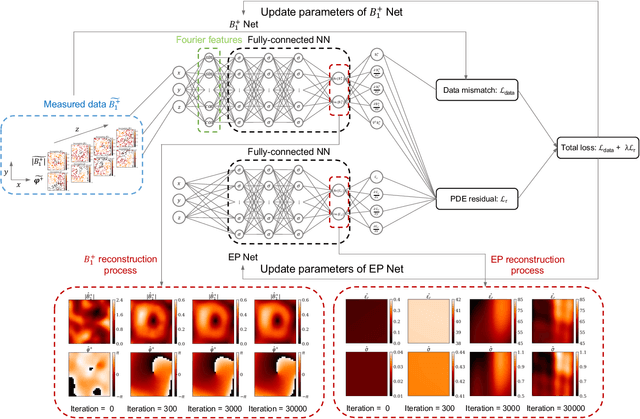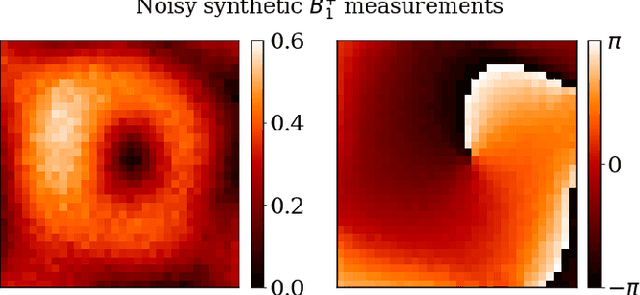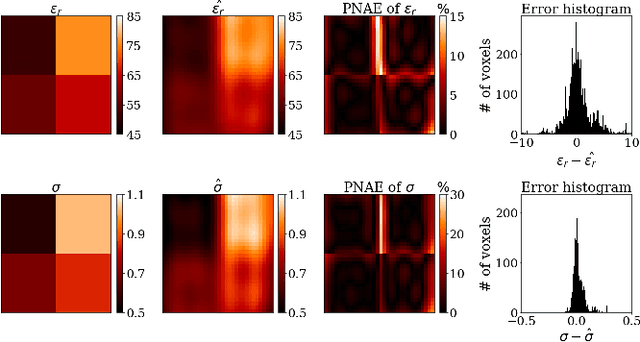Riccardo Lattanzi
PIFON-EPT: MR-Based Electrical Property Tomography Using Physics-Informed Fourier Networks
Feb 24, 2023



Abstract:\textit{Objective:} In this paper, we introduce Physics-Informed Fourier Networks (PIFONs) for Electrical Properties (EP) Tomography (EPT). Our novel deep learning-based method is capable of learning EPs globally by solving an inverse scattering problem based on noisy and/or incomplete magnetic resonance (MR) measurements. \textit{Methods:} We use two separate fully-connected neural networks, namely $B_1^{+}$ Net and EP Net, to learn the $B_1^{+}$ field and EPs at any location. A random Fourier features mapping is embedded into $B_1^{+}$ Net, which allows it to learn the $B_1^{+}$ field more efficiently. These two neural networks are trained jointly by minimizing the combination of a physics-informed loss and a data mismatch loss via gradient descent. \textit{Results:} We showed that PIFON-EPT could provide physically consistent reconstructions of EPs and transmit field in the whole domain of interest even when half of the noisy MR measurements of the entire volume was missing. The average error was $2.49\%$, $4.09\%$ and $0.32\%$ for the relative permittivity, conductivity and $B_{1}^{+}$, respectively, over the entire volume of the phantom. In experiments that admitted a zero assumption of $B_z$, PIFON-EPT could yield accurate EP predictions near the interface between regions of different EP values without requiring any boundary conditions. \textit{Conclusion:} This work demonstrated the feasibility of PIFON-EPT, suggesting it could be an accurate and effective method for electrical properties estimation. \textit{Significance:} PIFON-EPT can efficiently de-noise MR measurements, which shows the potential to improve other MR-based EPT techniques. Furthermore, it is the first time that MR-based EPT methods can reconstruct the EPs and $B_{1}^{+}$ field simultaneously from incomplete simulated noisy MR measurements.
MR-Based Electrical Property Reconstruction Using Physics-Informed Neural Networks
Oct 23, 2022Abstract:Electrical properties (EP), namely permittivity and electric conductivity, dictate the interactions between electromagnetic waves and biological tissue. EP can be potential biomarkers for pathology characterization, such as cancer, and improve therapeutic modalities, such radiofrequency hyperthermia and ablation. MR-based electrical properties tomography (MR-EPT) uses MR measurements to reconstruct the EP maps. Using the homogeneous Helmholtz equation, EP can be directly computed through calculations of second order spatial derivatives of the measured magnetic transmit or receive fields $(B_{1}^{+}, B_{1}^{-})$. However, the numerical approximation of derivatives leads to noise amplifications in the measurements and thus erroneous reconstructions. Recently, a noise-robust supervised learning-based method (DL-EPT) was introduced for EP reconstruction. However, the pattern-matching nature of such network does not allow it to generalize for new samples since the network's training is done on a limited number of simulated data. In this work, we leverage recent developments on physics-informed deep learning to solve the Helmholtz equation for the EP reconstruction. We develop deep neural network (NN) algorithms that are constrained by the Helmholtz equation to effectively de-noise the $B_{1}^{+}$ measurements and reconstruct EP directly at an arbitrarily high spatial resolution without requiring any known $B_{1}^{+}$ and EP distribution pairs.
 Add to Chrome
Add to Chrome Add to Firefox
Add to Firefox Add to Edge
Add to Edge